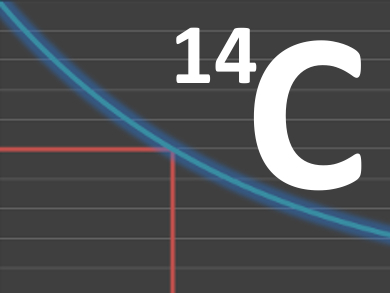On February 27, 1940, Martin Kamen and Samuel Ruben confirmed the existence of the carbon isotope 14C. Working at the University of California, Berkeley, CA, USA, they detected radioactivity in a sample of CO2 obtained by burning a graphite target that had been bombarded with deuterons in the lab’s cyclotron. Decaying to 14N through β emission, the isotope has a very long half life (later found to be 5730 years). This opened up new possibilities for using radioactive tracers to elucidate reaction mechanisms.
Building on Ruben’s and Kamen’s discovery, Willard Libby and colleagues developed radiocarbon dating in 1949. The age of organic objects can be calculated by comparing the ratio of remaining 14C in a sample to the atmospheric content at the time of death. This method had a tremendous impact on archaeology, as it allows to accurately date artifacts from a large timescale. For this discovery, Libby was awarded the 1960 Nobel Prize in Chemistry.
Samuel Ruben, born in 1913, studied chemistry at the University of California, Berkeley, where he received his Ph.D. in 1938. He stayed at UC Berkeley, working on chemistry, nuclear physics, and the elucidation of biochemical reation pathways under Ernest O. Lawrence together with Martin Kamen. Their experiments using 18O showed that the oxygen produced in photosynthesis stems from water and not from CO2. During the second World War, Ruben studied the effects of phosgene on lung tissue. He died after a tragic laboratory accident with the poisonous gas in September of 1943.
Martin D. Kamen, born in Toronto, Canada, in 1913, studied chemistry at the University of Chicago, IL, USA, where he received his Ph.D. in physical chemistry in 1936. He joined UC Berkeley’s Radiation Laboratory, working with Sam Ruben. Kamen was assigned to the Manhattan Project in 1943, working at Oak Ridge Laboratory, TN.
After his return to Berkeley, he faced allegations of being a spy because his parents imigrated from Russia and lost his position. Kamen’s struggle with these accusations continued well into the 1950s. In 1957, he joined Brandeis University Waltham, MA, USA, and in 1961 he joined the University of California, San Diego, USA, where he remained until his retirement in 1978. Martin Kamen died on August 31, 2002 in in Montecito, CA.
Martin Kamen is the answer to Guess the Chemist (38).
Selected Publications
- Radiant Science, Dark Politics: A Memoir of the Nuclear Age,
M. D. Kamen,
University of California Press 1986.
ISBN: 978-0-520-05897-2 - Age Determinations by Radiocarbon Content: Checks with Samples of Known Age,
J. R. Arnold, W. F. Libby,
Science 1949, 110, 678–680.
DOI: 10.1126/science.110.2869.678 - Long-Lived Radioactive Carbon: C14,
S. Ruben, M. D. Kamen,
Phys. Rev. 1941, 59, 349.
DOI: 10.1103/PhysRev.59.349 - Radioactive Carbon of Long Half-Life,
Samuel Ruben, Martin D. Kamen,
Phys. Rev. 1940, 57, 549.
DOI: 10.1103/PhysRev.57.549
Also of Interest
- Pharaoh Time,
ChemistryViews.org 2010.
Accurate chronology of the kings of ancient Egypt mapped using a radiocarbon analysis of short-lived plant remains from the region




